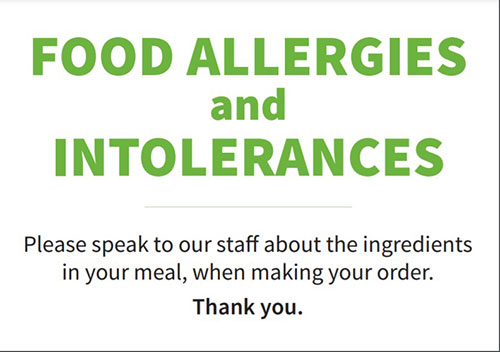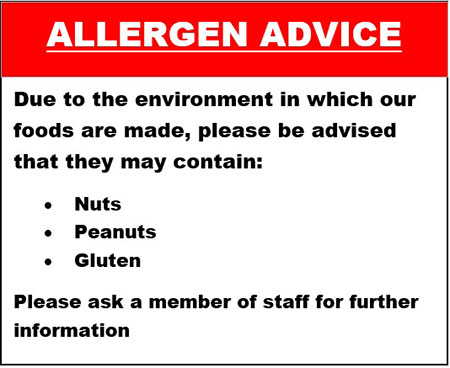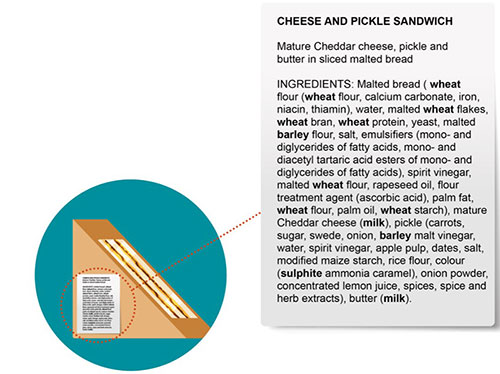
Are you in the business of manufacturing, selling, supplying food?
If yes then you need to know about food allergens and intolerances.
Here at Cumbria Trading Standards we have put together answers to the top 10 allergen and intolerance questions we are often asked.
We hope that this toolkit will help you to understand the law and what you need to do to help keep your customers safe.
Top 10 allergen and intolerance questions we get asked:
Every food business who is manufacturing, selling, supplying, advertising, labelling, giving out free samples or distributing foods need to know about allergens and intolerances and how they are managed within their business.
Business types will include:
- Food factories
- Restaurants and cafes
- Wholesalers
- Promotion samples
- Supermarkets
- Corner shops
- Petrol stations
- Market stalls and mobile units
- Takeaways
- Schools
- Hospitals
- Bakers
Plus many more too!
Your customers also need to know about allergens contained within your foods to help them make an informed choice about what is and is not safe for them to eat.
How to find the allergen information and how it is to be given to customers will depend on how the food is sold. We will cover this in Question 8.

Many people in the UK are living with a food allergy, intolerance, or Coeliac Disease. This is when their body's immune system reacts unusually to specific foods or ingredients.
Although allergic reactions are often mild, they can be very serious, even fatal.
The Food Information Regulations 2014 require food businesses to provide accurate allergen information upon request.
It is a criminal offence not to provide this information when it is asked for and you could face enforcement action if you fail to do so.
There are 14 Food allergens recognised in law which you will need to look for in your foods and premises. These are:
- cereals containing gluten, such as wheat, rye, barley, oats, spelt, kamut and their hybridised strains
- peanuts (also called groundnuts)
- nuts, such as almonds, hazelnuts, walnuts, Brazil nuts, cashews, pecans, pistachios, macadamias and Queensland nuts
- fish
- crustaceans (includes crabs, lobsters, shrimps and prawns)
- molluscs (includes mussels, cockles, oysters, scallops, squid and octopus)
- sesame seeds
- eggs
- milk and milk products (including lactose)
- soy beans
- celery
- lupin
- mustard
- sulphur dioxide and sulphites at levels above 10 mg/kg or 10 mg/litre expressed as SO2
If a person asks you about the allergens in your food (or if you voluntarily provide allergen information), you have a legal responsibility to ensure that information when given is accurate, clear and not misleading.
Allergen requests relating to foods other than the 14 listed above (such as strawberries, kiwis, tomatoes) must also be taken seriously as it is an offence to supply unsafe food.
The consequences of not providing accurate allergen information to your customers could be fatal.
We recommend that all food businesses undertake an 'allergen audit' to identify which allergens are present in the foods you make, sell, supply or give away. This should include (but is not limited to) every:
- Dish
- Side dish
- Accompaniment
- Condiments
- Pastes, spice mixes and blends
- Sauces
- Drink
- Specials
- Promotions
- Taster samples
You will need to check the ingredients of all your food products to see if any of the 14 allergens listed in Question 3 will be contained within the final food item.
You will also need to check any 'bought in' ingredients labels too.
It is best practice to keep a written record of the allergen information you obtain as part of your audit.
You can do this on an allergen menu chart and chef recipe cards. You can download free templates and guidance from the Food Standards Agency.
We have put together an online webinar which explains in detail allergen labelling for prepacked, lose and prepacked for direct sale foods.
TOP TIP:
Don't forget to review and update your allergen audit record every time you get a delivery or change supplier. Doing this can help to make sure your allergen information is up to date.
We also recommend that you read and apply the Food Standards Agency website's allergen checklist.
The allergen audit and checklist will help form part of your Allergen Management System along with staff training (refer to question 5)
Staff training and communication is extremely important where food allergen information is concerned.
We recommend that all staff are regularly trained on your food allergen procedures and that a written record of staff training is kept.
You can use the free online allergen training created by the Food Standards Agency for you and all your staff and the Online food safety training.
The Allergen guidance for food businesses can also help you ensure your staff know their responsibilities and what they need to do if they are asked about allergens in your food
It is important that your staff know how and where they can access your accurate allergen information. A written work instruction on this could help you evidence your procedures and assist you with your due diligence records.
If you want to provide allergy information to your customers verbally, you must display an allergen and intolerance sign. This sign will invite the customer to ask you about allergens in your foods. Download a free copy of the sign.
Example sign:

If there is a risk of allergen cross-contamination on your premises, you may display a statement to tell customers of that risk.
Before using a 'May Contain' statement, you must have carefully considered the possibility of cross contamination, which you can do via a risk assessment.
Example statement:

The statement should be displayed at each place the consumer can place their order, in the same way as the allergen information. This could be on a sign at the till or on a menu.
The 'may contain' statement does not replace the duty to inform consumers about the presence of allergens. It also should not be used as a general disclaimer if there is no risk of cross contamination.
If an ingredient you buy in has a "may contain" statement on it then you will need to treat it as if that allergen is present and will therefore be present in your final food. Allergens are not removed by heat processes such as cooking.
If you are not completely confident that you can produce an allergen-free meal, you should refuse the request.
If your customer suffers an allergic reaction after eating a meal you claimed was 'free' of the allergen in question, you may have committed a criminal offence and be liable for civil action. In the most extreme cases, the customer could die.
How you sell, package or serve food on your premises will decide how allergen information should be provided or labelled.
The allergen information rules are different for the three different types of food placed on the market:
- Prepacked Foods
- Non Prepacked Foods
- Prepacked for Direct Sale Foods
If you are not sure which of these categories your food falls into, please use the decision making tool from the Food Standards Agency to find out how your food should be labelled with allergen information.
On 1 October 2021 food allergen labelling is changing due to the introduction of "Natasha's Law".
This change means that all prepacked for direct sale food will need to have a label showing the name of the food and a full ingredients list. The allergens present within the food need to be stated and emphasised within the ingredients list which can be done so in bold, capitals, underlined or in a different colour.
Food allergen labelling example:

A statement on the label stating "For allergens see ingredients listed in bold/underlined etc" will now be needed on both prepacked and prepacked for direct sale food labels.
These need to be in line with the legal requirements that apply to naming the food and listing ingredients.
You can find out more about Natasha's law and the changes you may need to make to your current labelling at:
Video: Food Standards Agency explains - Prepacked for direct sale
You can find out more about food allergen requirements:
- On the Food Standards Agency Website:
- On the Business Companion website
and by contacting Cumbria Trading Standards Service by:
- Telephone: 01539 713 594
- Email:trading.standards@cumbria.gov.uk